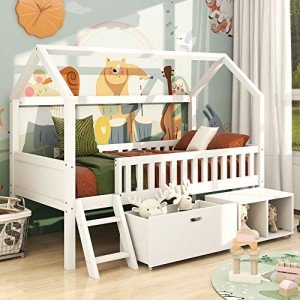Beware Of This Common Mistake When It Comes To Your Bunks
Bunks: The Versatile Space-Saving Solution for Modern Living
In today's fast-paced world, where metropolitan living spaces are shrinking and the demand for adaptability and usefulness is increasing, bunks have actually become a popular solution. Bunks are not merely a kind of bed; they represent a sophisticated method to optimizing space, promoting social interaction, and supplying comfy sleeping arrangements. This post will explore the various types of bunks readily available, their advantages, and how they can change both little and large living spaces.
Understanding Bunks: What Are They?
Bunks , typically described as bunk beds, are 2 or more beds stacked on top of each other. They are developed to save flooring space, making them perfect for children's rooms, hostels, and even adult living circumstances. Bunk beds are readily available in different styles and setups, from traditional models to modern-day, designer interpretations.
Kinds of Bunks
Type of Bunk
Description
Twin-over-Twin
Two twin beds stacked on top of each other. Perfect for kids sharing a space.
Twin-over-Full
A twin bed on top and a bigger complete bed on the bottom. Great for accommodating visitors.
Full-over-Full
2 full-sized beds stacked together. Perfect for older kids or adults.
L-Shaped Bunk Bed
Beds are set up in an L shape, permitting a corner positioning and added space beneath.
Loft Beds
Just the leading bunk is present, leaving space for a desk, couch, or storage beneath.
Triple Bunk Beds
Three beds stacked vertically, excellent for optimizing vertical space.
Benefits of Using Bunks
Space Efficiency: Bunks are created to make use of vertical space, making them ideal for little bed rooms or apartments where flooring space is limited.
Economical: Investing in a bunk bed can be more cost-effective than acquiring numerous separate beds, specifically for growing families or those with regular guests.
Flexible Designs: Many bunks come with add-ons, such as desks, storage drawers, or futons, enabling flexible use of the location.
Social Interaction: Bunk beds welcome camaraderie among siblings and buddies, promoting a sense of connection.
Creative Use of Space: Bunk beds motivate imagination in room design, allowing for lively styles and vibrant decor that can make a bedroom feel unique and welcoming.
Practical Considerations
Height Limitations: When selecting a bunk bed, it is vital to consider the height of the ceiling in the room. Step Childrens Bunk Beds to make sure there is adequate clearance above the leading bunk for safety and convenience.
Weight Restrictions: Each bunk has a particular weight limit. Parents ought to evaluate the weight of those utilizing it, particularly when it comes to adults or heavier adolescents sharing the bed.
Security Features: Features such as guardrails, strong ladders, and security certifications are crucial for making sure the bunk bed's security, especially for more youthful users.
Bunks for Various Living Situations
Household Homes
In household homes, bunks offer a useful option for brother or sisters sharing a room or accommodating sleepovers. Bunk beds can be stylishly incorporated into a kid's space while offering ample space for play.
Hostels and Vacation Rentals
For hostels and trip leasings, bunk beds optimize sleeping plans without compromising comfort. Such setups provide an economical way to accommodate a larger variety of visitors.
College Dormitories
In college dormitories, bunks assist take advantage of the minimal square footage readily available, enabling for more space to mingle and study.
Small Apartments
In little city apartments, lofted bunk beds create extra space for living locations, work spaces, or storage, making life more manageable in compact environments.
Maintenance and Care of Bunks
Maintaining a bunk bed is important for guaranteeing its longevity. Here are a few ideas:
Regular Inspections: Check for any loose screws or bolts and tighten them as essential.
Cleanliness: Dust and tidy the bunks routinely to prevent allergens and ensure a clean sleeping environment.
Mattress Care: Use a quality mattress protector to preserve health and extend the life of the bed mattress.
Age Appropriateness: Upgrade to a bigger, more tough bunk as children grow or when the present plan no longer meets the requirements of its residents.
Regularly Asked Questions (FAQs)
1. Are bunk beds safe for children?
Yes, bunk beds can be safe for children if they are constructed with security functions like guardrails and a steady ladder. Always monitor younger children when they are utilizing bunk beds.
2. What age is suitable for a kid to sleep on the top bunk?
Many manufacturers suggest that children under the age of 6 ought to not sleep on the upper bunk due to safety concerns.
3. How much weight can bunk beds usually hold?
Weight capacities differ based upon the design and products but generally vary from 200 to 400 pounds. Constantly check the maker's guidelines.
4. Can bunk beds be separated into two single beds?
Numerous bunk beds are designed to be convertible, enabling them to be separated into 2 specific beds. It's necessary to check the item specs before purchasing.
5. What sort of mattress is best for a bunk bed?
A medium-firm bed mattress is frequently recommended as it offers sufficient assistance without being too heavy or soft, which can pose safety issues.
Bunks are more than just beds. They are innovative space-saving options that deal with the requirements of modern-day living. With numerous styles readily available, they offer convenience and performance for households, guests, and individuals alike. By focusing on safety and upkeep, owners can make sure that their bunk beds end up being a valued part of their home for numerous years to come. Whether for spirited kids or accommodating visitors, bunk beds offer a stylish and useful service to the challenge of minimal space.
